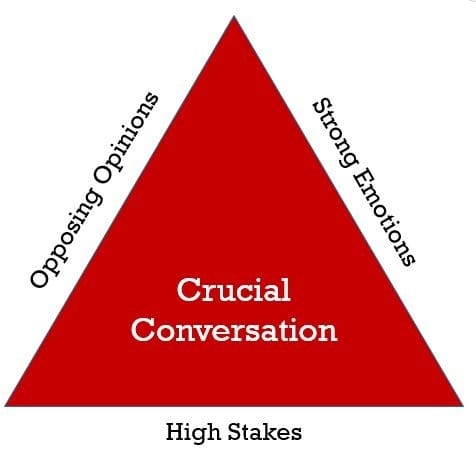
No one would ever say that approaching a co-worker, family member or loved one with a difficult conversation is my strong suit. Confrontation has always been challenging for me, and if I find myself in an environment of hostile dialogue, I tend to retreat to keep the peace. But as a leader at MyITpros, I have accepted that however much I want to avoid difficult conversations, there are occasions when these are required. The key is to learn to handle them well.
Crucial Conversations: Tools for Talking When Stakes Are High
In the book “Crucial Conversations: Tools for Talking When Stakes Are High,” authors Kerry Patterson, Joseph Grenny, Ron McMillan and Al Switzler deliver a methodology to help the reader prepare for and handle crucial conversations in a healthy way. The ultimate goal: for both parties to come to a mutual purpose and understanding. That said, the methodology extends beyond the book itself—in fact, I attended a two-day training session on the topic in 2017, which I found invaluable. But first things first: What is a crucial conversation?
According to the book, a crucial conversation includes opposing opinions, strong emotions and high stakes. This type of interaction may sound extreme, but examples are all around us. Here are just a few:
- Giving co-workers feedback that will be difficult for them to hear
- Speaking to employees about how they can improve their performance
- Approaching managers with misgivings
- Telling friends that their actions were upsetting

The way you conduct crucial conversations will have a lasting effect on your relationships. When such an exchange is managed well, the quality of the relationship improves; poor management, on the other hand, can lead to a breakdown. Unfortunately, people tend not to handle these conversations well—or at all. Rather, they exist in an unhealthy environment while hoping the issue will go away on its own.
Having crucial conversations
The book advises that you first work on yourself and your mental state before the conversation begins. This initial stage of self-reflection is the most critical part of the process because if you haven’t worked out what your emotions are and what stories you’ve told yourself, it will be much more difficult to approach the conversation in a healthy way. In dialogue, you want to create a safe place where both parties are comfortable sharing their thoughts and opinions freely and openly, after which point creating a mutual purpose—and, ultimately, a resolution or compromise—becomes much easier. The result? An improved relationship.
Although I’ve participated in more than 30 hours of training, that certainly doesn’t mean I’ve mastered the program. Even the most experienced experts still struggle to apply the core tenets in real life, so it’s probably no surprise that I retreated into unhealthy dialogue soon after attending my first training session. After all, when emotions are high, remembering to step back and utilize the tools from the book can be extremely challenging. However, I firmly believe that even when I draw upon mere fractions of the practice, my conversations improve as a result.
Another great thing about this book is that people from all walks of life can relate to and benefit from it—and, in turn, bring it into their businesses. At MyITpros, we decided there was value in sharing the methods and ideology across our organization, so I will be teaching various employees how to have crucial conversations both in and out of the office. I look forward to passing on this knowledge with the hope that everyone will work to promote healthier dialogue and feel a bit happier in their lives, and I encourage anyone interested in learning more to contact me directly!




